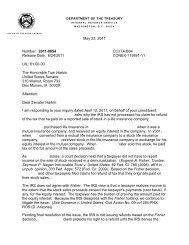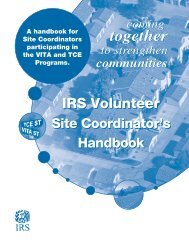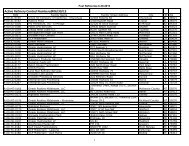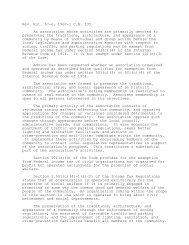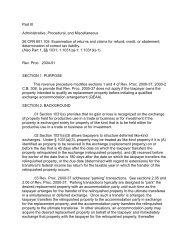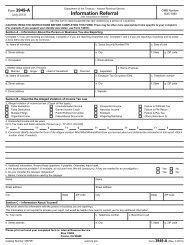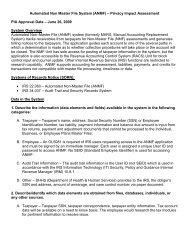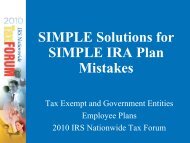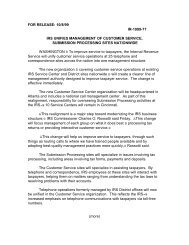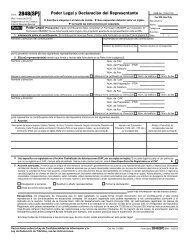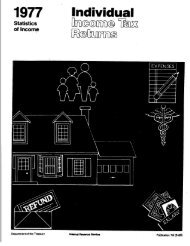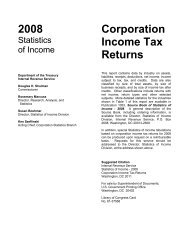Publication 1436 (Rev. 10-2012) - Internal Revenue Service
Publication 1436 (Rev. 10-2012) - Internal Revenue Service
Publication 1436 (Rev. 10-2012) - Internal Revenue Service
You also want an ePaper? Increase the reach of your titles
YUMPU automatically turns print PDFs into web optimized ePapers that Google loves.
▶ If you checked “No” on line 13a, go to line 14. Otherwise, go to<br />
line 13b.<br />
DRAFT AS OF<br />
child? See the instructions before answering . . . . . . . . . .<br />
April 6, <strong>2012</strong><br />
Version A, Cycle 1<br />
Form 8867 (<strong>2012</strong>) Page 2<br />
Part II Taxpayers With a Child<br />
Caution. If there is more than one child, complete lines 8 through 14 for<br />
one child before going to the next column.<br />
Child 1 Child 2 Child 3<br />
8 Child’s name . . . . . . . . . . . . . . . . . . . . . Jack Cosmos Julie Cosmos John Cosmos<br />
9 Is the child the taxpayer’s son, daughter, stepchild, foster child, brother, sister,<br />
stepbrother, stepsister, half brother, half sister, or a descendant of any of them? ✔ Yes No ✔ Yes No ✔ Yes No<br />
<strong>10</strong> Is either of the following true?<br />
• The child is unmarried, or<br />
• The child is married, can be claimed as the taxpayer’s dependent, and is<br />
not filing a joint return (or is filing it only as a claim for refund). ✔ Yes No ✔ Yes No ✔ Yes No<br />
11 Did the child live with the taxpayer in the United States for over half of the<br />
year? See the instructions before answering . . . . . . . . . . ✔ Yes No ✔ Yes No ✔ Yes No<br />
12 Was the child (at the end of <strong>2012</strong>)—<br />
• Under age 19 and younger than the taxpayer (or the taxpayer’s spouse,<br />
if the taxpayer files jointly),<br />
• Under age 24, a full-time student, and younger than the taxpayer (or the<br />
taxpayer’s spouse, if the taxpayer files jointly), or<br />
• Any age and permanently and totally disabled? . . . . . . . . ✔ Yes No ✔ Yes No ✔ Yes No<br />
13a<br />
▶ If you checked “Yes” on lines 9, <strong>10</strong>, 11, and 12, the child is the<br />
taxpayer’s qualifying child; go to line 13a. If you checked “No” on line 9,<br />
<strong>10</strong>, 11, or 12, the child is not the taxpayer’s qualifying child; see the<br />
instructions for line 12.<br />
Could any other person check “Yes” on lines 9, <strong>10</strong>, 11, and 12 for the child? Yes ✔ No Yes ✔ No Yes ✔ No<br />
b Enter the child’s relationship to the other person(s) . . . . . . . .<br />
c Under the tiebreaker rules, is the child treated as the taxpayer’s qualifying<br />
▶ If you checked “Yes” on line 13c, go to line 14. If you checked “No,” the<br />
taxpayer cannot take the EIC based on this child and cannot take the EIC for<br />
taxpayers who do not have a qualifying child. If there is more than one child,<br />
see the Note at the bottom of this page. If you checked “Don’t know,” explain<br />
to the taxpayer that, under the tiebreaker rules, the taxpayer’s EIC and other<br />
tax benefits may be disallowed. Then, if the taxpayer wants to take the EIC<br />
based on this child, complete lines 14 and 15. If not, and there are no other<br />
qualifying children, the taxpayer cannot take the EIC, including the EIC for<br />
taxpayers without a qualifying child; do not complete Part III. If there is more<br />
than one child, see the Note at the bottom of this page.<br />
Yes No<br />
Don’t know<br />
Yes No<br />
Don’t know<br />
Yes No<br />
Don’t know<br />
14 Does the qualifying child have an SSN that allows him or her to work or is<br />
valid for EIC purposes? See the instructions before answering . . . . ✔ Yes No ✔ Yes No ✔ Yes No<br />
15<br />
▶ If you checked “No” on line 14, the taxpayer cannot take the EIC<br />
based on this child and cannot take the EIC for taxpayers who do not<br />
have a qualifying child. If there is more than one child, see the Note at<br />
the bottom of this page. If you checked “Yes” on line 14, continue.<br />
Are the taxpayer’s earned income and adjusted gross income each less<br />
than the limit that applies to the taxpayer for <strong>2012</strong>? See Pub. 596 for the<br />
limit . . . . . . . . . . . . . . . . . . . . . . . . ✔ Yes No<br />
▶ If you checked “No” on line 15, stop; the taxpayer cannot take the<br />
EIC. If you checked “Yes” on line 15, the taxpayer can take the EIC.<br />
Complete Schedule EIC and attach it to the taxpayer’s return. If there<br />
are two or three qualifying children with valid SSNs, list them on<br />
Schedule EIC in the same order as they are listed here. If the taxpayer’s<br />
EIC was reduced or disallowed for a year after 1996, see Pub. 596 to see<br />
if Form 8862 must be filed. Go to line 20.<br />
Note. If you checked “No” on line 13c or 14 but there is more than one<br />
child, complete lines 8 through 14 for the other child(ren) (but for no more<br />
than three qualifying children). Also do this if you checked “Don’t know”<br />
on line 13c and the taxpayer is not taking the EIC based on this child.<br />
70<br />
Form 8867 (<strong>2012</strong>)



